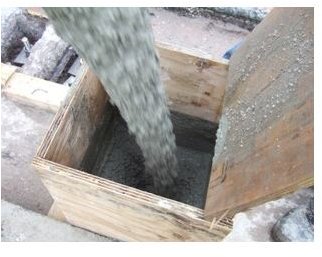Self Compacting Concrete
Introduction
Concrete is the most basic element of for any kind of construction work. No matter what type of building structure it is, the concrete used should be sturdy and well compacted. The main reasons for compacting any type of concrete are:
- To ensure attaining maximum density by removal of any entrapped air.
- To ensure that the concrete used is in full contact with both the steel reinforcement and the form work.
Ensuring the above points not only provide additional strength to the structure but also good finish and appearance to the final product. The compacting of any conventional concrete is done through external force using mechanical devices.
Image Credits:Self Compacting Concrete Pour at Highways website (https://www.highways.gov.uk/roads/projects/images/Self_Compacting_Concrete_Pour.JPG )
Self Compacting Concrete (SCC)
Unlike the conventional concrete, self compacting concrete doesn’t require compacting using external force from mechanical equipments such as an immersion vibrator; instead SSC is designed in such as way that it gets compacted using its own weight and characteristics.
Once applied, the self compacting property enables the concrete to fully reinforce around the steel structures and completely fill the space within the framework. The self compacting of concrete is achieved without losing any kind of strength, stability, or change in properties.
How is SCC made?
Self compacting concrete is a type of concrete, which is not a product of mixing substances having different properties but a combination of several mixes having the same flow characteristics.
Manufacturing of a Self Compacting Concrete requires three main aspects to be fulfilled.They are as follows:
- High amount of water reducing substance or super plasticizers is added for obtaining high flowing characteristics.
- A type of aggregate mixture is added to gain the desired compactness. Note that the aggregate content is of round shape and proportional in size in order to increase the locking tendency of the concrete.
- Alteration of fluid properties is done to ensure a cohesive mix which will keep the aggregate and paste together. These fluid properties can be achieved by adding a high quantity of fine content such as cement fly-ash or by adding viscosity modifying admixtures (VMA).
Two Main Methods of Making SCC
There are two known and main methods for making SCC.They are as followed :
Powder Method :
In this method superplasticisers are mixed with cementitious materials such as sly ash, slag, etc. to form a paste. The paste increases the flow of the concrete and holds all the constituents together.
Admixture method:
In this method instead of the conventional superplasticisers, a new type of superplasticisers known as polycarboxylate superplasticisers are used. This not only increases the flow capability of the concrete but also improves the viscosity and the constituent’s retention property.
Usage of Self-Compacting Cements has increased tremendously in the past few years. SCC not only ensures a structure with robust characteristics but also helps in timely completion of building structures.
References
https://www.concretebasics.org/articlesinfo/scc8.php
https://www.theconstructioncivil.com/2010/02/self-compacting-concrete.html
